Business Environment Report: Sainsbury's Stakeholder Analysis
VerifiedAdded on 2020/02/05
|12
|3936
|76
Report
AI Summary
This report provides a comprehensive analysis of Sainsbury's business environment. It begins by examining the purpose of different organizational types, comparing their missions, goals, and strategic objectives, and assessing how well they meet stakeholder objectives. The report then delves into the responsibilities of an organization and the strategies employed to fulfill them. It further explores economic systems, resource allocation, and the impact of fiscal and monetary policies on business activities. Additionally, it investigates the influence of competition policies and regulatory mechanisms. The report also examines how market structures determine pricing and output decisions, and how market forces shape organizational responses, using Sainsbury as a case study. Finally, it assesses the significance of international trade, global factors, and European Union policies on UK businesses, concluding with an overview of the key findings.
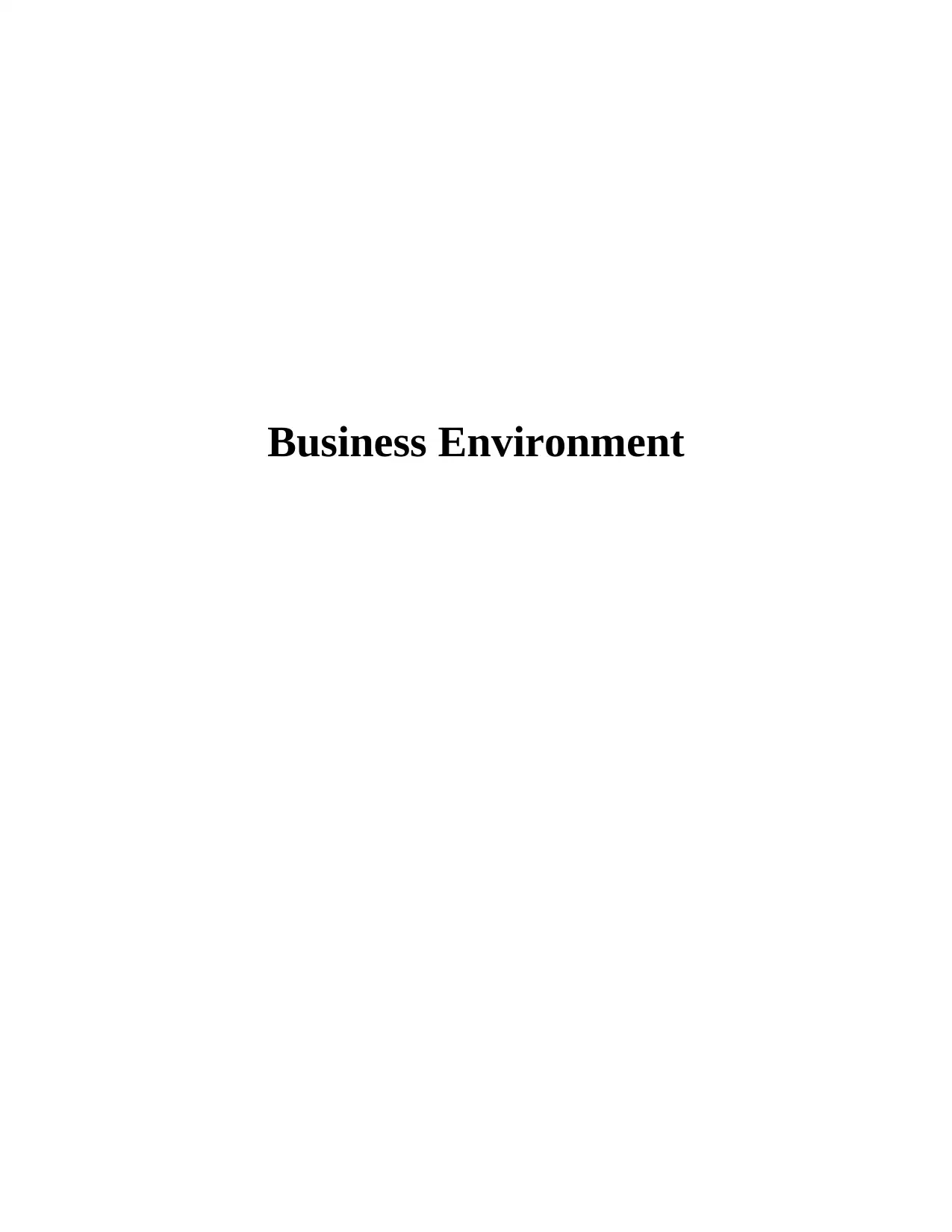
Business Environment
Paraphrase This Document
Need a fresh take? Get an instant paraphrase of this document with our AI Paraphraser
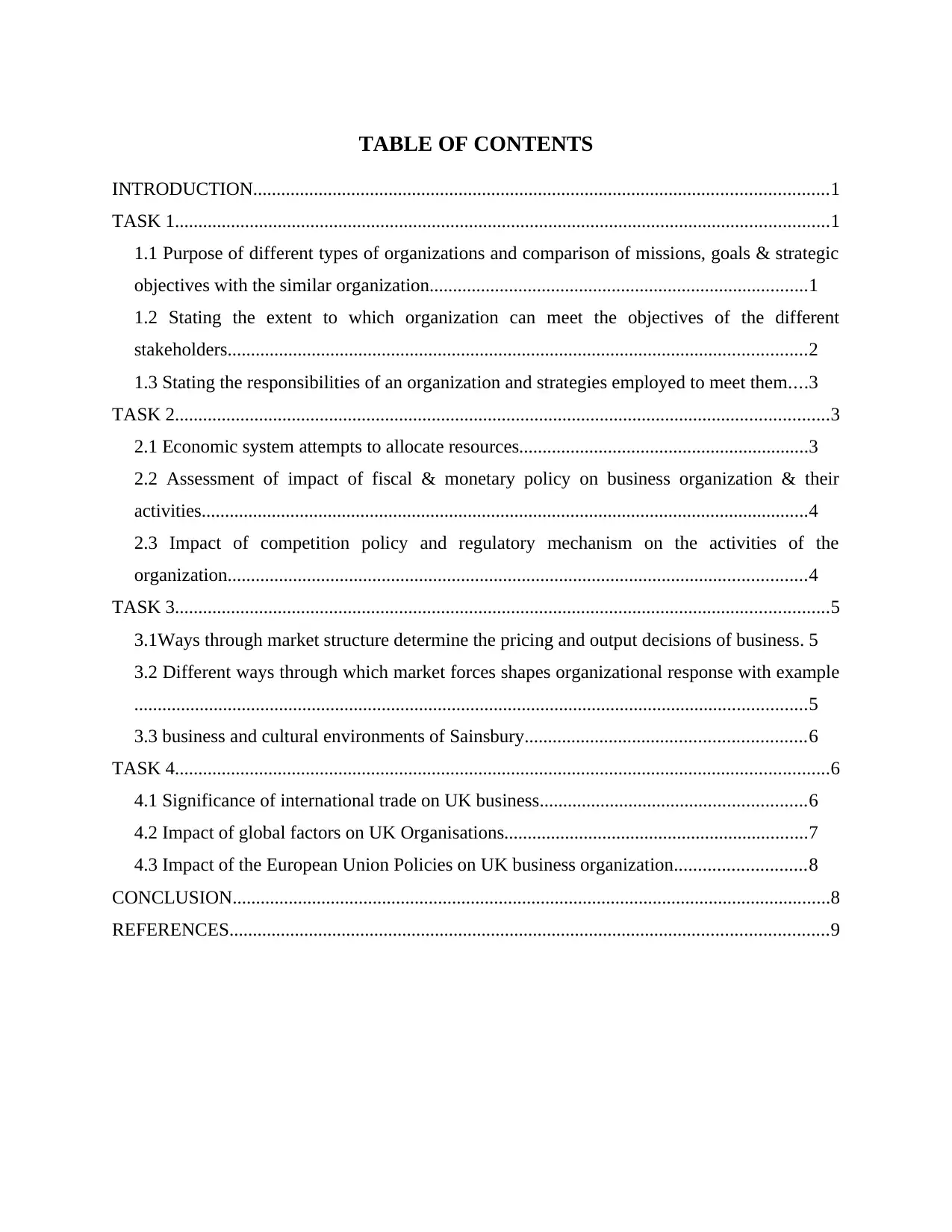
TABLE OF CONTENTS
INTRODUCTION...........................................................................................................................1
TASK 1............................................................................................................................................1
1.1 Purpose of different types of organizations and comparison of missions, goals & strategic
objectives with the similar organization.................................................................................1
1.2 Stating the extent to which organization can meet the objectives of the different
stakeholders............................................................................................................................2
1.3 Stating the responsibilities of an organization and strategies employed to meet them....3
TASK 2............................................................................................................................................3
2.1 Economic system attempts to allocate resources..............................................................3
2.2 Assessment of impact of fiscal & monetary policy on business organization & their
activities..................................................................................................................................4
2.3 Impact of competition policy and regulatory mechanism on the activities of the
organization............................................................................................................................4
TASK 3............................................................................................................................................5
3.1Ways through market structure determine the pricing and output decisions of business. 5
3.2 Different ways through which market forces shapes organizational response with example
................................................................................................................................................5
3.3 business and cultural environments of Sainsbury............................................................6
TASK 4............................................................................................................................................6
4.1 Significance of international trade on UK business.........................................................6
4.2 Impact of global factors on UK Organisations.................................................................7
4.3 Impact of the European Union Policies on UK business organization............................8
CONCLUSION................................................................................................................................8
REFERENCES................................................................................................................................9
INTRODUCTION...........................................................................................................................1
TASK 1............................................................................................................................................1
1.1 Purpose of different types of organizations and comparison of missions, goals & strategic
objectives with the similar organization.................................................................................1
1.2 Stating the extent to which organization can meet the objectives of the different
stakeholders............................................................................................................................2
1.3 Stating the responsibilities of an organization and strategies employed to meet them....3
TASK 2............................................................................................................................................3
2.1 Economic system attempts to allocate resources..............................................................3
2.2 Assessment of impact of fiscal & monetary policy on business organization & their
activities..................................................................................................................................4
2.3 Impact of competition policy and regulatory mechanism on the activities of the
organization............................................................................................................................4
TASK 3............................................................................................................................................5
3.1Ways through market structure determine the pricing and output decisions of business. 5
3.2 Different ways through which market forces shapes organizational response with example
................................................................................................................................................5
3.3 business and cultural environments of Sainsbury............................................................6
TASK 4............................................................................................................................................6
4.1 Significance of international trade on UK business.........................................................6
4.2 Impact of global factors on UK Organisations.................................................................7
4.3 Impact of the European Union Policies on UK business organization............................8
CONCLUSION................................................................................................................................8
REFERENCES................................................................................................................................9
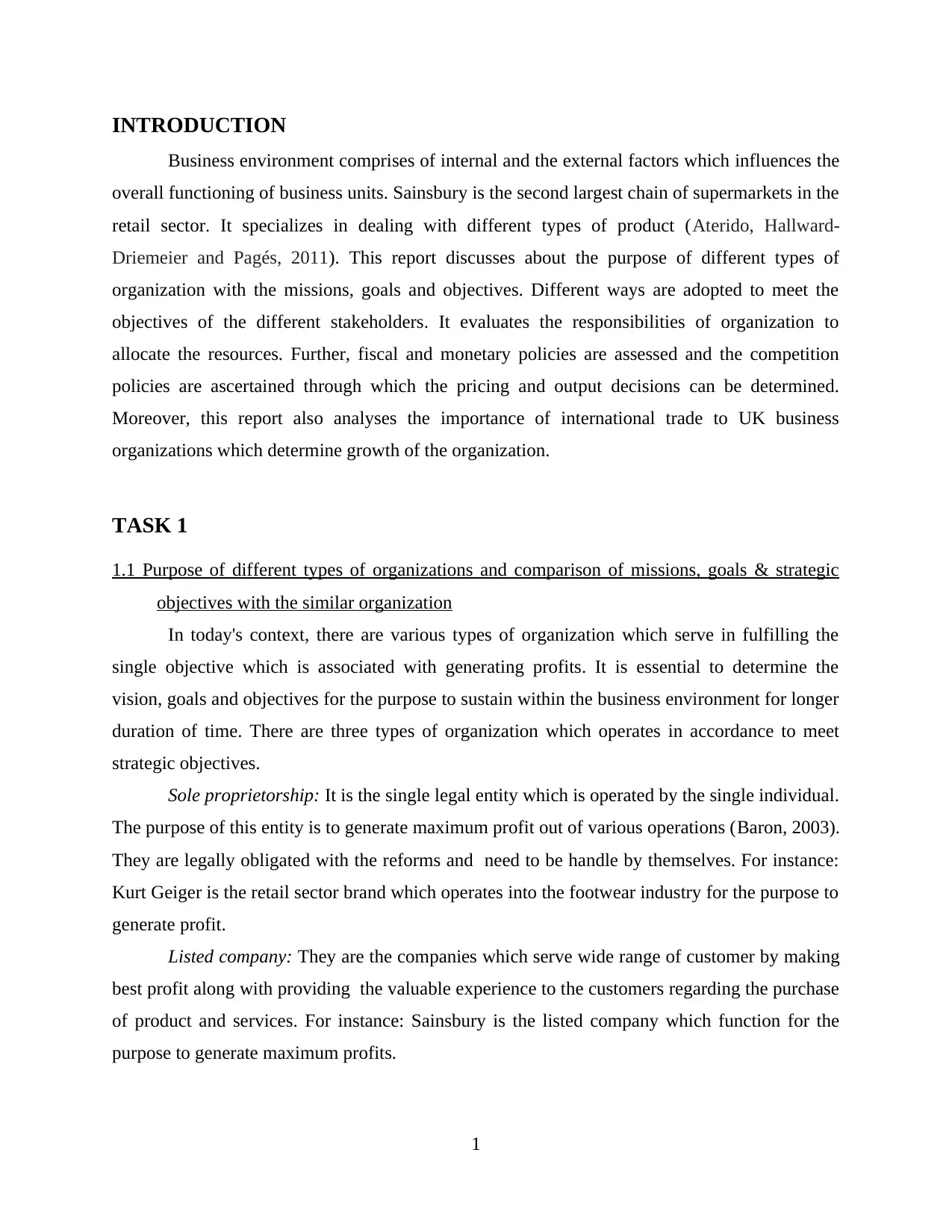
INTRODUCTION
Business environment comprises of internal and the external factors which influences the
overall functioning of business units. Sainsbury is the second largest chain of supermarkets in the
retail sector. It specializes in dealing with different types of product (Aterido, Hallward-
Driemeier and Pagés, 2011). This report discusses about the purpose of different types of
organization with the missions, goals and objectives. Different ways are adopted to meet the
objectives of the different stakeholders. It evaluates the responsibilities of organization to
allocate the resources. Further, fiscal and monetary policies are assessed and the competition
policies are ascertained through which the pricing and output decisions can be determined.
Moreover, this report also analyses the importance of international trade to UK business
organizations which determine growth of the organization.
TASK 1
1.1 Purpose of different types of organizations and comparison of missions, goals & strategic
objectives with the similar organization
In today's context, there are various types of organization which serve in fulfilling the
single objective which is associated with generating profits. It is essential to determine the
vision, goals and objectives for the purpose to sustain within the business environment for longer
duration of time. There are three types of organization which operates in accordance to meet
strategic objectives.
Sole proprietorship: It is the single legal entity which is operated by the single individual.
The purpose of this entity is to generate maximum profit out of various operations (Baron, 2003).
They are legally obligated with the reforms and need to be handle by themselves. For instance:
Kurt Geiger is the retail sector brand which operates into the footwear industry for the purpose to
generate profit.
Listed company: They are the companies which serve wide range of customer by making
best profit along with providing the valuable experience to the customers regarding the purchase
of product and services. For instance: Sainsbury is the listed company which function for the
purpose to generate maximum profits.
1
Business environment comprises of internal and the external factors which influences the
overall functioning of business units. Sainsbury is the second largest chain of supermarkets in the
retail sector. It specializes in dealing with different types of product (Aterido, Hallward-
Driemeier and Pagés, 2011). This report discusses about the purpose of different types of
organization with the missions, goals and objectives. Different ways are adopted to meet the
objectives of the different stakeholders. It evaluates the responsibilities of organization to
allocate the resources. Further, fiscal and monetary policies are assessed and the competition
policies are ascertained through which the pricing and output decisions can be determined.
Moreover, this report also analyses the importance of international trade to UK business
organizations which determine growth of the organization.
TASK 1
1.1 Purpose of different types of organizations and comparison of missions, goals & strategic
objectives with the similar organization
In today's context, there are various types of organization which serve in fulfilling the
single objective which is associated with generating profits. It is essential to determine the
vision, goals and objectives for the purpose to sustain within the business environment for longer
duration of time. There are three types of organization which operates in accordance to meet
strategic objectives.
Sole proprietorship: It is the single legal entity which is operated by the single individual.
The purpose of this entity is to generate maximum profit out of various operations (Baron, 2003).
They are legally obligated with the reforms and need to be handle by themselves. For instance:
Kurt Geiger is the retail sector brand which operates into the footwear industry for the purpose to
generate profit.
Listed company: They are the companies which serve wide range of customer by making
best profit along with providing the valuable experience to the customers regarding the purchase
of product and services. For instance: Sainsbury is the listed company which function for the
purpose to generate maximum profits.
1
⊘ This is a preview!⊘
Do you want full access?
Subscribe today to unlock all pages.

Trusted by 1+ million students worldwide
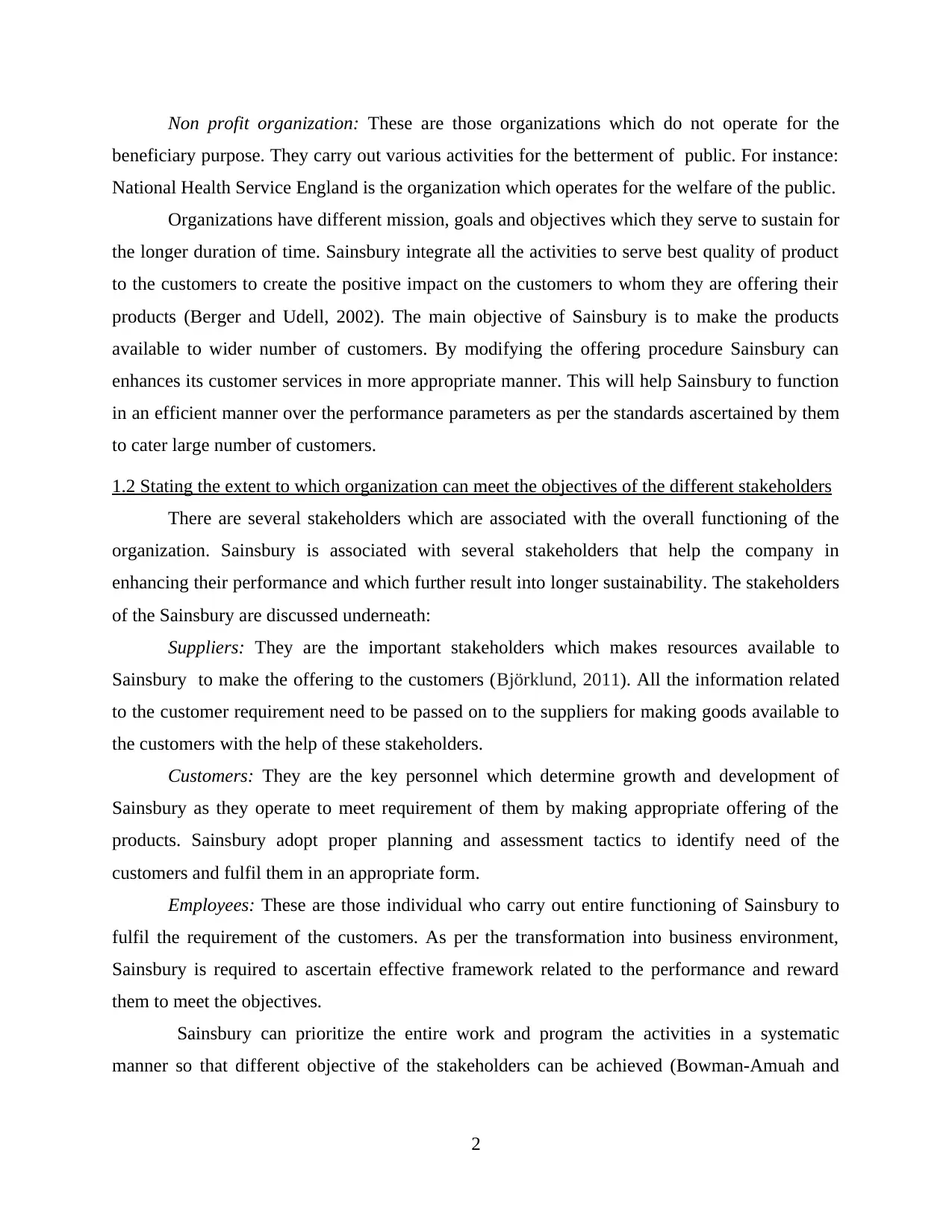
Non profit organization: These are those organizations which do not operate for the
beneficiary purpose. They carry out various activities for the betterment of public. For instance:
National Health Service England is the organization which operates for the welfare of the public.
Organizations have different mission, goals and objectives which they serve to sustain for
the longer duration of time. Sainsbury integrate all the activities to serve best quality of product
to the customers to create the positive impact on the customers to whom they are offering their
products (Berger and Udell, 2002). The main objective of Sainsbury is to make the products
available to wider number of customers. By modifying the offering procedure Sainsbury can
enhances its customer services in more appropriate manner. This will help Sainsbury to function
in an efficient manner over the performance parameters as per the standards ascertained by them
to cater large number of customers.
1.2 Stating the extent to which organization can meet the objectives of the different stakeholders
There are several stakeholders which are associated with the overall functioning of the
organization. Sainsbury is associated with several stakeholders that help the company in
enhancing their performance and which further result into longer sustainability. The stakeholders
of the Sainsbury are discussed underneath:
Suppliers: They are the important stakeholders which makes resources available to
Sainsbury to make the offering to the customers (Björklund, 2011). All the information related
to the customer requirement need to be passed on to the suppliers for making goods available to
the customers with the help of these stakeholders.
Customers: They are the key personnel which determine growth and development of
Sainsbury as they operate to meet requirement of them by making appropriate offering of the
products. Sainsbury adopt proper planning and assessment tactics to identify need of the
customers and fulfil them in an appropriate form.
Employees: These are those individual who carry out entire functioning of Sainsbury to
fulfil the requirement of the customers. As per the transformation into business environment,
Sainsbury is required to ascertain effective framework related to the performance and reward
them to meet the objectives.
Sainsbury can prioritize the entire work and program the activities in a systematic
manner so that different objective of the stakeholders can be achieved (Bowman-Amuah and
2
beneficiary purpose. They carry out various activities for the betterment of public. For instance:
National Health Service England is the organization which operates for the welfare of the public.
Organizations have different mission, goals and objectives which they serve to sustain for
the longer duration of time. Sainsbury integrate all the activities to serve best quality of product
to the customers to create the positive impact on the customers to whom they are offering their
products (Berger and Udell, 2002). The main objective of Sainsbury is to make the products
available to wider number of customers. By modifying the offering procedure Sainsbury can
enhances its customer services in more appropriate manner. This will help Sainsbury to function
in an efficient manner over the performance parameters as per the standards ascertained by them
to cater large number of customers.
1.2 Stating the extent to which organization can meet the objectives of the different stakeholders
There are several stakeholders which are associated with the overall functioning of the
organization. Sainsbury is associated with several stakeholders that help the company in
enhancing their performance and which further result into longer sustainability. The stakeholders
of the Sainsbury are discussed underneath:
Suppliers: They are the important stakeholders which makes resources available to
Sainsbury to make the offering to the customers (Björklund, 2011). All the information related
to the customer requirement need to be passed on to the suppliers for making goods available to
the customers with the help of these stakeholders.
Customers: They are the key personnel which determine growth and development of
Sainsbury as they operate to meet requirement of them by making appropriate offering of the
products. Sainsbury adopt proper planning and assessment tactics to identify need of the
customers and fulfil them in an appropriate form.
Employees: These are those individual who carry out entire functioning of Sainsbury to
fulfil the requirement of the customers. As per the transformation into business environment,
Sainsbury is required to ascertain effective framework related to the performance and reward
them to meet the objectives.
Sainsbury can prioritize the entire work and program the activities in a systematic
manner so that different objective of the stakeholders can be achieved (Bowman-Amuah and
2
Paraphrase This Document
Need a fresh take? Get an instant paraphrase of this document with our AI Paraphraser
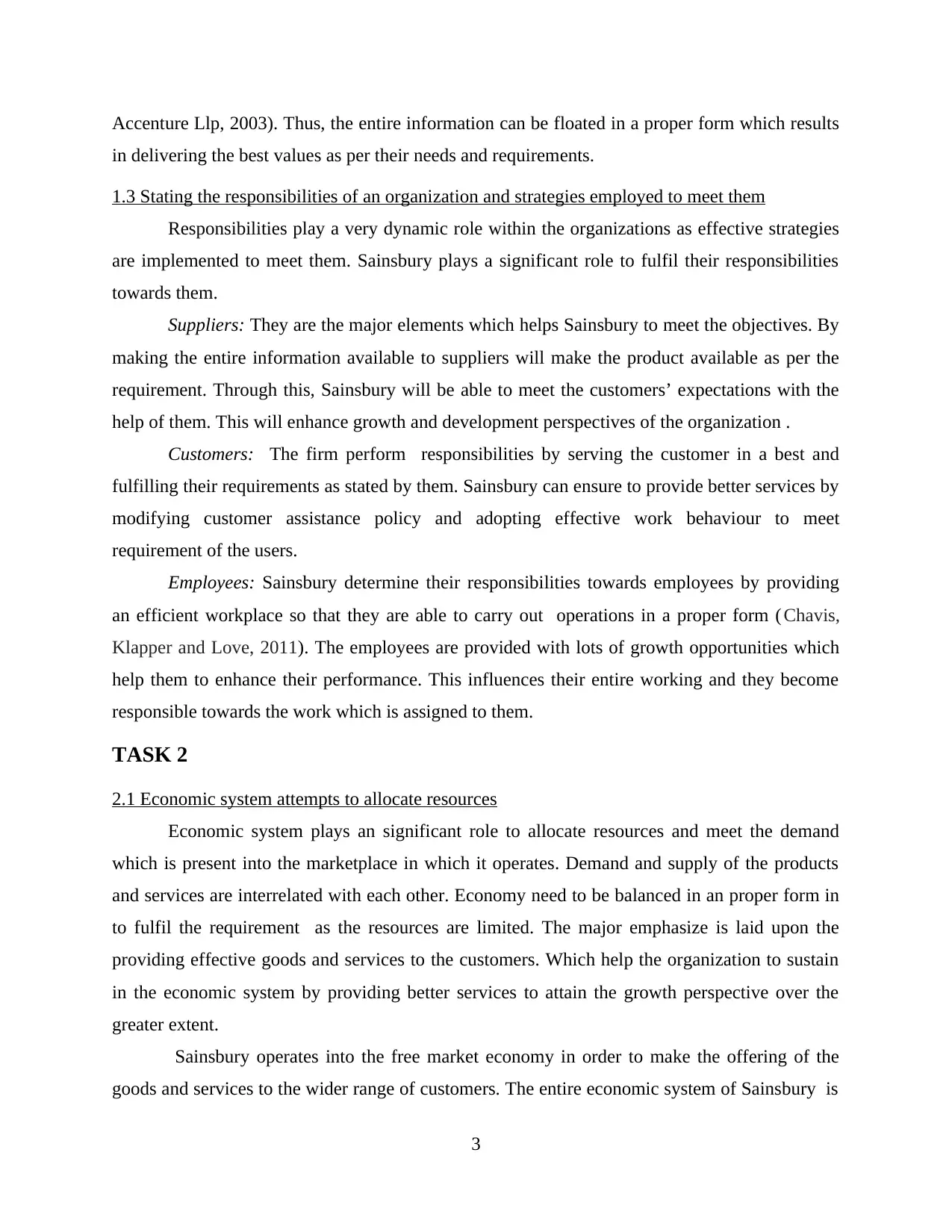
Accenture Llp, 2003). Thus, the entire information can be floated in a proper form which results
in delivering the best values as per their needs and requirements.
1.3 Stating the responsibilities of an organization and strategies employed to meet them
Responsibilities play a very dynamic role within the organizations as effective strategies
are implemented to meet them. Sainsbury plays a significant role to fulfil their responsibilities
towards them.
Suppliers: They are the major elements which helps Sainsbury to meet the objectives. By
making the entire information available to suppliers will make the product available as per the
requirement. Through this, Sainsbury will be able to meet the customers’ expectations with the
help of them. This will enhance growth and development perspectives of the organization .
Customers: The firm perform responsibilities by serving the customer in a best and
fulfilling their requirements as stated by them. Sainsbury can ensure to provide better services by
modifying customer assistance policy and adopting effective work behaviour to meet
requirement of the users.
Employees: Sainsbury determine their responsibilities towards employees by providing
an efficient workplace so that they are able to carry out operations in a proper form ( Chavis,
Klapper and Love, 2011). The employees are provided with lots of growth opportunities which
help them to enhance their performance. This influences their entire working and they become
responsible towards the work which is assigned to them.
TASK 2
2.1 Economic system attempts to allocate resources
Economic system plays an significant role to allocate resources and meet the demand
which is present into the marketplace in which it operates. Demand and supply of the products
and services are interrelated with each other. Economy need to be balanced in an proper form in
to fulfil the requirement as the resources are limited. The major emphasize is laid upon the
providing effective goods and services to the customers. Which help the organization to sustain
in the economic system by providing better services to attain the growth perspective over the
greater extent.
Sainsbury operates into the free market economy in order to make the offering of the
goods and services to the wider range of customers. The entire economic system of Sainsbury is
3
in delivering the best values as per their needs and requirements.
1.3 Stating the responsibilities of an organization and strategies employed to meet them
Responsibilities play a very dynamic role within the organizations as effective strategies
are implemented to meet them. Sainsbury plays a significant role to fulfil their responsibilities
towards them.
Suppliers: They are the major elements which helps Sainsbury to meet the objectives. By
making the entire information available to suppliers will make the product available as per the
requirement. Through this, Sainsbury will be able to meet the customers’ expectations with the
help of them. This will enhance growth and development perspectives of the organization .
Customers: The firm perform responsibilities by serving the customer in a best and
fulfilling their requirements as stated by them. Sainsbury can ensure to provide better services by
modifying customer assistance policy and adopting effective work behaviour to meet
requirement of the users.
Employees: Sainsbury determine their responsibilities towards employees by providing
an efficient workplace so that they are able to carry out operations in a proper form ( Chavis,
Klapper and Love, 2011). The employees are provided with lots of growth opportunities which
help them to enhance their performance. This influences their entire working and they become
responsible towards the work which is assigned to them.
TASK 2
2.1 Economic system attempts to allocate resources
Economic system plays an significant role to allocate resources and meet the demand
which is present into the marketplace in which it operates. Demand and supply of the products
and services are interrelated with each other. Economy need to be balanced in an proper form in
to fulfil the requirement as the resources are limited. The major emphasize is laid upon the
providing effective goods and services to the customers. Which help the organization to sustain
in the economic system by providing better services to attain the growth perspective over the
greater extent.
Sainsbury operates into the free market economy in order to make the offering of the
goods and services to the wider range of customers. The entire economic system of Sainsbury is
3
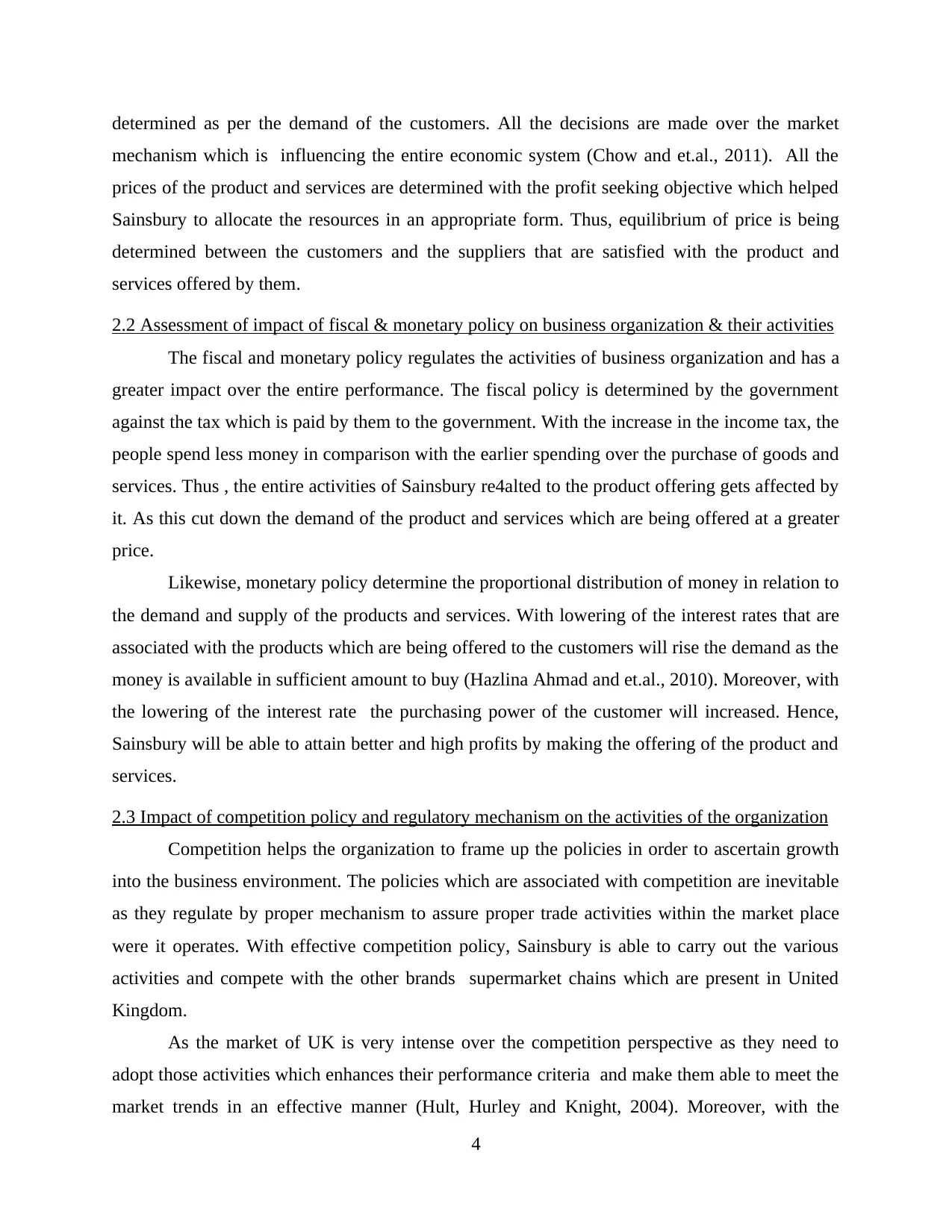
determined as per the demand of the customers. All the decisions are made over the market
mechanism which is influencing the entire economic system (Chow and et.al., 2011). All the
prices of the product and services are determined with the profit seeking objective which helped
Sainsbury to allocate the resources in an appropriate form. Thus, equilibrium of price is being
determined between the customers and the suppliers that are satisfied with the product and
services offered by them.
2.2 Assessment of impact of fiscal & monetary policy on business organization & their activities
The fiscal and monetary policy regulates the activities of business organization and has a
greater impact over the entire performance. The fiscal policy is determined by the government
against the tax which is paid by them to the government. With the increase in the income tax, the
people spend less money in comparison with the earlier spending over the purchase of goods and
services. Thus , the entire activities of Sainsbury re4alted to the product offering gets affected by
it. As this cut down the demand of the product and services which are being offered at a greater
price.
Likewise, monetary policy determine the proportional distribution of money in relation to
the demand and supply of the products and services. With lowering of the interest rates that are
associated with the products which are being offered to the customers will rise the demand as the
money is available in sufficient amount to buy (Hazlina Ahmad and et.al., 2010). Moreover, with
the lowering of the interest rate the purchasing power of the customer will increased. Hence,
Sainsbury will be able to attain better and high profits by making the offering of the product and
services.
2.3 Impact of competition policy and regulatory mechanism on the activities of the organization
Competition helps the organization to frame up the policies in order to ascertain growth
into the business environment. The policies which are associated with competition are inevitable
as they regulate by proper mechanism to assure proper trade activities within the market place
were it operates. With effective competition policy, Sainsbury is able to carry out the various
activities and compete with the other brands supermarket chains which are present in United
Kingdom.
As the market of UK is very intense over the competition perspective as they need to
adopt those activities which enhances their performance criteria and make them able to meet the
market trends in an effective manner (Hult, Hurley and Knight, 2004). Moreover, with the
4
mechanism which is influencing the entire economic system (Chow and et.al., 2011). All the
prices of the product and services are determined with the profit seeking objective which helped
Sainsbury to allocate the resources in an appropriate form. Thus, equilibrium of price is being
determined between the customers and the suppliers that are satisfied with the product and
services offered by them.
2.2 Assessment of impact of fiscal & monetary policy on business organization & their activities
The fiscal and monetary policy regulates the activities of business organization and has a
greater impact over the entire performance. The fiscal policy is determined by the government
against the tax which is paid by them to the government. With the increase in the income tax, the
people spend less money in comparison with the earlier spending over the purchase of goods and
services. Thus , the entire activities of Sainsbury re4alted to the product offering gets affected by
it. As this cut down the demand of the product and services which are being offered at a greater
price.
Likewise, monetary policy determine the proportional distribution of money in relation to
the demand and supply of the products and services. With lowering of the interest rates that are
associated with the products which are being offered to the customers will rise the demand as the
money is available in sufficient amount to buy (Hazlina Ahmad and et.al., 2010). Moreover, with
the lowering of the interest rate the purchasing power of the customer will increased. Hence,
Sainsbury will be able to attain better and high profits by making the offering of the product and
services.
2.3 Impact of competition policy and regulatory mechanism on the activities of the organization
Competition helps the organization to frame up the policies in order to ascertain growth
into the business environment. The policies which are associated with competition are inevitable
as they regulate by proper mechanism to assure proper trade activities within the market place
were it operates. With effective competition policy, Sainsbury is able to carry out the various
activities and compete with the other brands supermarket chains which are present in United
Kingdom.
As the market of UK is very intense over the competition perspective as they need to
adopt those activities which enhances their performance criteria and make them able to meet the
market trends in an effective manner (Hult, Hurley and Knight, 2004). Moreover, with the
4
⊘ This is a preview!⊘
Do you want full access?
Subscribe today to unlock all pages.

Trusted by 1+ million students worldwide
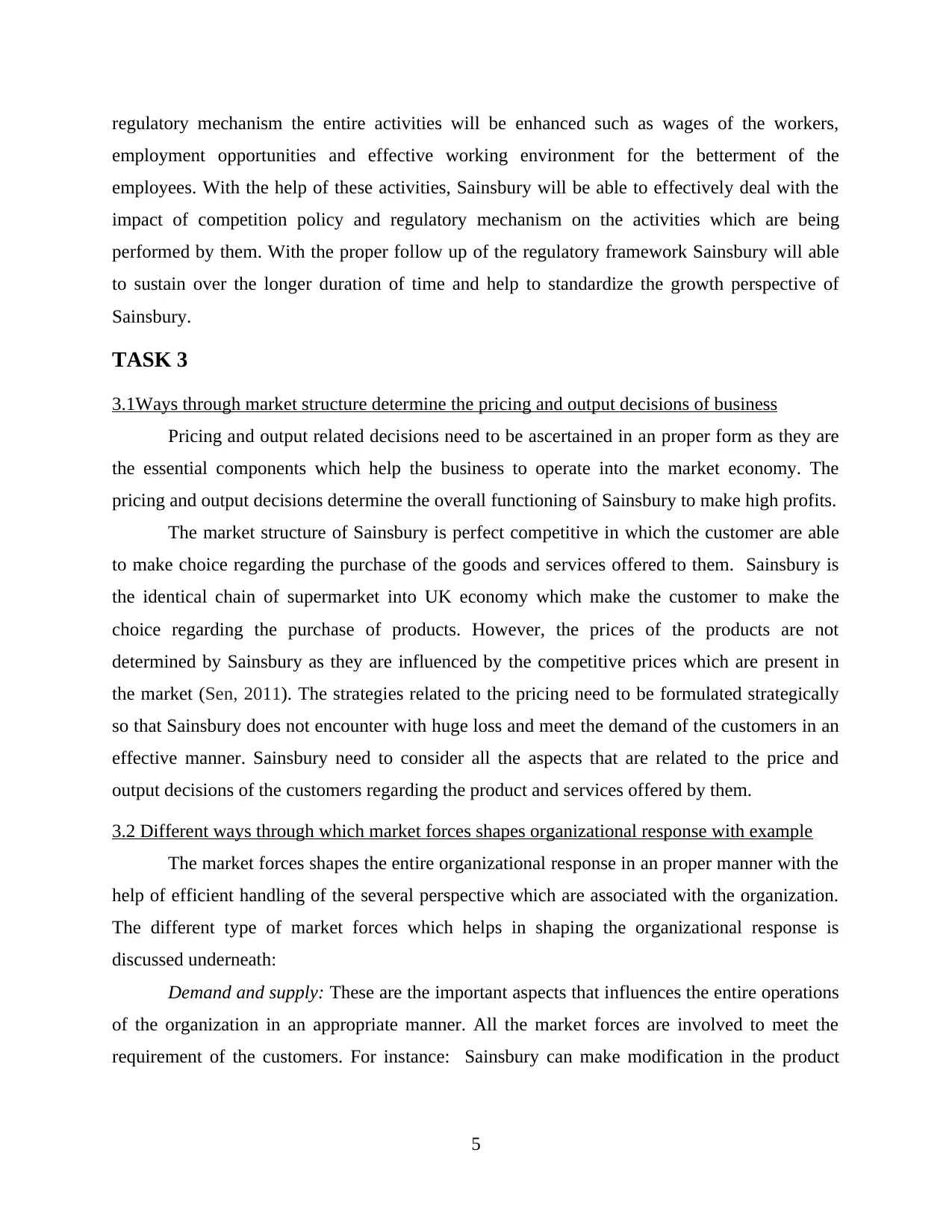
regulatory mechanism the entire activities will be enhanced such as wages of the workers,
employment opportunities and effective working environment for the betterment of the
employees. With the help of these activities, Sainsbury will be able to effectively deal with the
impact of competition policy and regulatory mechanism on the activities which are being
performed by them. With the proper follow up of the regulatory framework Sainsbury will able
to sustain over the longer duration of time and help to standardize the growth perspective of
Sainsbury.
TASK 3
3.1Ways through market structure determine the pricing and output decisions of business
Pricing and output related decisions need to be ascertained in an proper form as they are
the essential components which help the business to operate into the market economy. The
pricing and output decisions determine the overall functioning of Sainsbury to make high profits.
The market structure of Sainsbury is perfect competitive in which the customer are able
to make choice regarding the purchase of the goods and services offered to them. Sainsbury is
the identical chain of supermarket into UK economy which make the customer to make the
choice regarding the purchase of products. However, the prices of the products are not
determined by Sainsbury as they are influenced by the competitive prices which are present in
the market (Sen, 2011). The strategies related to the pricing need to be formulated strategically
so that Sainsbury does not encounter with huge loss and meet the demand of the customers in an
effective manner. Sainsbury need to consider all the aspects that are related to the price and
output decisions of the customers regarding the product and services offered by them.
3.2 Different ways through which market forces shapes organizational response with example
The market forces shapes the entire organizational response in an proper manner with the
help of efficient handling of the several perspective which are associated with the organization.
The different type of market forces which helps in shaping the organizational response is
discussed underneath:
Demand and supply: These are the important aspects that influences the entire operations
of the organization in an appropriate manner. All the market forces are involved to meet the
requirement of the customers. For instance: Sainsbury can make modification in the product
5
employment opportunities and effective working environment for the betterment of the
employees. With the help of these activities, Sainsbury will be able to effectively deal with the
impact of competition policy and regulatory mechanism on the activities which are being
performed by them. With the proper follow up of the regulatory framework Sainsbury will able
to sustain over the longer duration of time and help to standardize the growth perspective of
Sainsbury.
TASK 3
3.1Ways through market structure determine the pricing and output decisions of business
Pricing and output related decisions need to be ascertained in an proper form as they are
the essential components which help the business to operate into the market economy. The
pricing and output decisions determine the overall functioning of Sainsbury to make high profits.
The market structure of Sainsbury is perfect competitive in which the customer are able
to make choice regarding the purchase of the goods and services offered to them. Sainsbury is
the identical chain of supermarket into UK economy which make the customer to make the
choice regarding the purchase of products. However, the prices of the products are not
determined by Sainsbury as they are influenced by the competitive prices which are present in
the market (Sen, 2011). The strategies related to the pricing need to be formulated strategically
so that Sainsbury does not encounter with huge loss and meet the demand of the customers in an
effective manner. Sainsbury need to consider all the aspects that are related to the price and
output decisions of the customers regarding the product and services offered by them.
3.2 Different ways through which market forces shapes organizational response with example
The market forces shapes the entire organizational response in an proper manner with the
help of efficient handling of the several perspective which are associated with the organization.
The different type of market forces which helps in shaping the organizational response is
discussed underneath:
Demand and supply: These are the important aspects that influences the entire operations
of the organization in an appropriate manner. All the market forces are involved to meet the
requirement of the customers. For instance: Sainsbury can make modification in the product
5
Paraphrase This Document
Need a fresh take? Get an instant paraphrase of this document with our AI Paraphraser
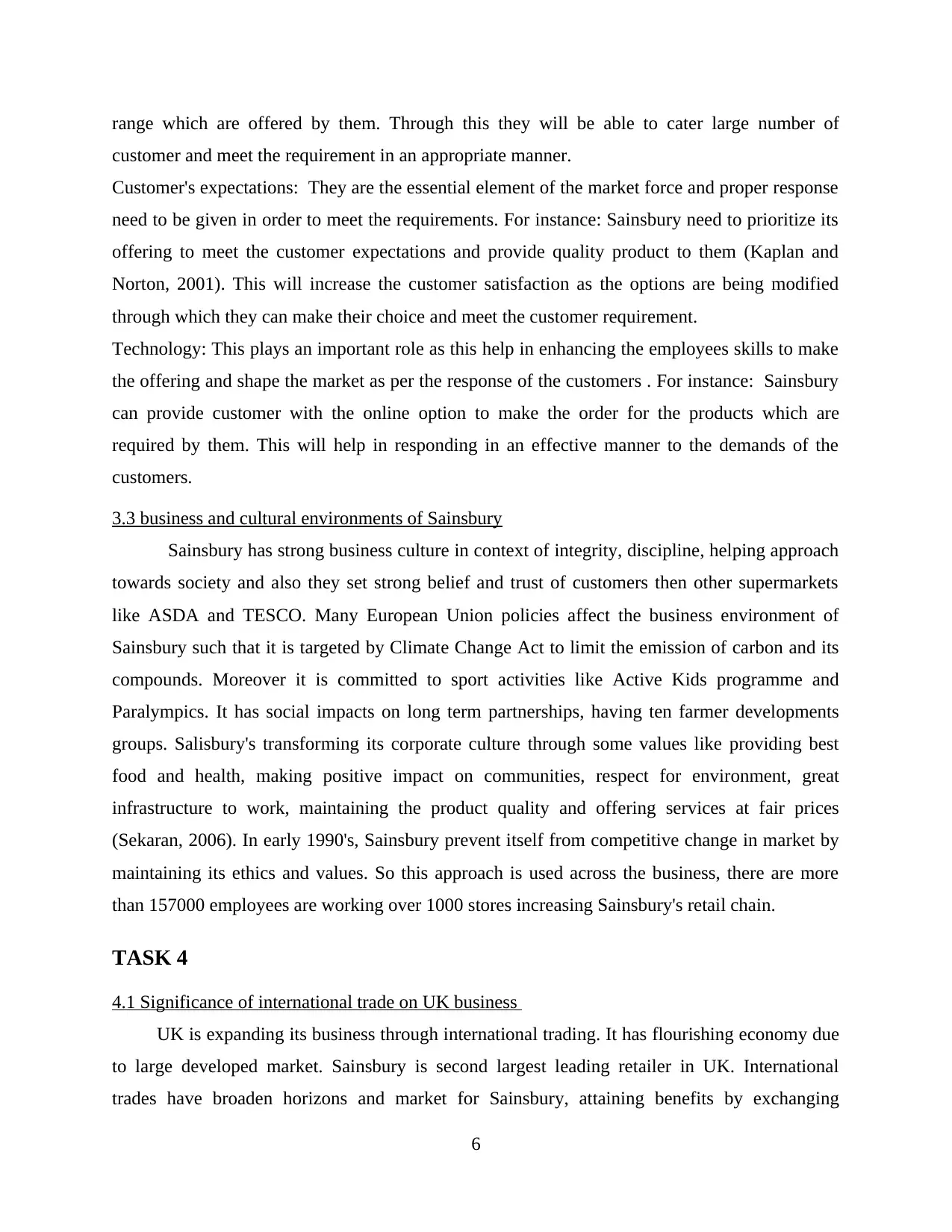
range which are offered by them. Through this they will be able to cater large number of
customer and meet the requirement in an appropriate manner.
Customer's expectations: They are the essential element of the market force and proper response
need to be given in order to meet the requirements. For instance: Sainsbury need to prioritize its
offering to meet the customer expectations and provide quality product to them (Kaplan and
Norton, 2001). This will increase the customer satisfaction as the options are being modified
through which they can make their choice and meet the customer requirement.
Technology: This plays an important role as this help in enhancing the employees skills to make
the offering and shape the market as per the response of the customers . For instance: Sainsbury
can provide customer with the online option to make the order for the products which are
required by them. This will help in responding in an effective manner to the demands of the
customers.
3.3 business and cultural environments of Sainsbury
Sainsbury has strong business culture in context of integrity, discipline, helping approach
towards society and also they set strong belief and trust of customers then other supermarkets
like ASDA and TESCO. Many European Union policies affect the business environment of
Sainsbury such that it is targeted by Climate Change Act to limit the emission of carbon and its
compounds. Moreover it is committed to sport activities like Active Kids programme and
Paralympics. It has social impacts on long term partnerships, having ten farmer developments
groups. Salisbury's transforming its corporate culture through some values like providing best
food and health, making positive impact on communities, respect for environment, great
infrastructure to work, maintaining the product quality and offering services at fair prices
(Sekaran, 2006). In early 1990's, Sainsbury prevent itself from competitive change in market by
maintaining its ethics and values. So this approach is used across the business, there are more
than 157000 employees are working over 1000 stores increasing Sainsbury's retail chain.
TASK 4
4.1 Significance of international trade on UK business
UK is expanding its business through international trading. It has flourishing economy due
to large developed market. Sainsbury is second largest leading retailer in UK. International
trades have broaden horizons and market for Sainsbury, attaining benefits by exchanging
6
customer and meet the requirement in an appropriate manner.
Customer's expectations: They are the essential element of the market force and proper response
need to be given in order to meet the requirements. For instance: Sainsbury need to prioritize its
offering to meet the customer expectations and provide quality product to them (Kaplan and
Norton, 2001). This will increase the customer satisfaction as the options are being modified
through which they can make their choice and meet the customer requirement.
Technology: This plays an important role as this help in enhancing the employees skills to make
the offering and shape the market as per the response of the customers . For instance: Sainsbury
can provide customer with the online option to make the order for the products which are
required by them. This will help in responding in an effective manner to the demands of the
customers.
3.3 business and cultural environments of Sainsbury
Sainsbury has strong business culture in context of integrity, discipline, helping approach
towards society and also they set strong belief and trust of customers then other supermarkets
like ASDA and TESCO. Many European Union policies affect the business environment of
Sainsbury such that it is targeted by Climate Change Act to limit the emission of carbon and its
compounds. Moreover it is committed to sport activities like Active Kids programme and
Paralympics. It has social impacts on long term partnerships, having ten farmer developments
groups. Salisbury's transforming its corporate culture through some values like providing best
food and health, making positive impact on communities, respect for environment, great
infrastructure to work, maintaining the product quality and offering services at fair prices
(Sekaran, 2006). In early 1990's, Sainsbury prevent itself from competitive change in market by
maintaining its ethics and values. So this approach is used across the business, there are more
than 157000 employees are working over 1000 stores increasing Sainsbury's retail chain.
TASK 4
4.1 Significance of international trade on UK business
UK is expanding its business through international trading. It has flourishing economy due
to large developed market. Sainsbury is second largest leading retailer in UK. International
trades have broaden horizons and market for Sainsbury, attaining benefits by exchanging
6
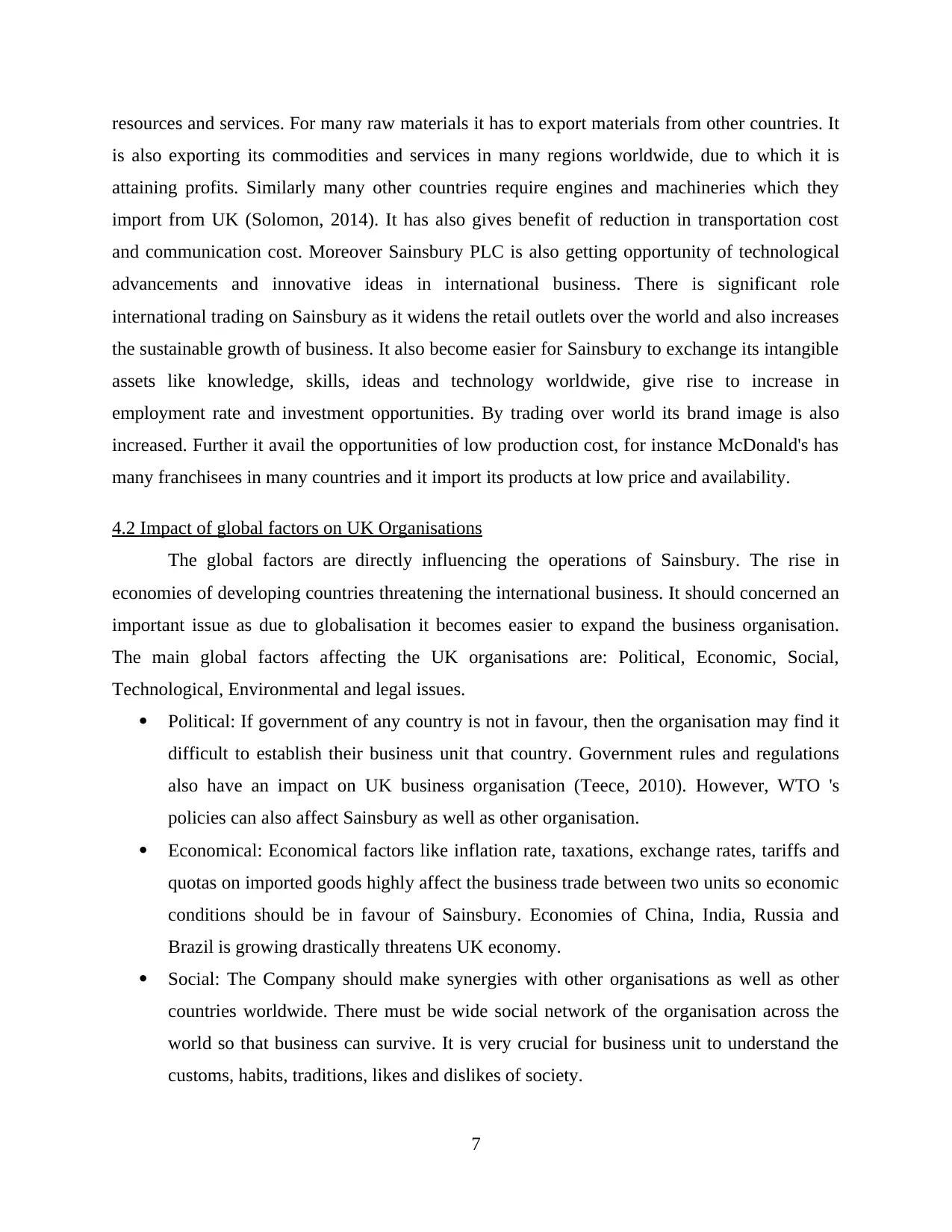
resources and services. For many raw materials it has to export materials from other countries. It
is also exporting its commodities and services in many regions worldwide, due to which it is
attaining profits. Similarly many other countries require engines and machineries which they
import from UK (Solomon, 2014). It has also gives benefit of reduction in transportation cost
and communication cost. Moreover Sainsbury PLC is also getting opportunity of technological
advancements and innovative ideas in international business. There is significant role
international trading on Sainsbury as it widens the retail outlets over the world and also increases
the sustainable growth of business. It also become easier for Sainsbury to exchange its intangible
assets like knowledge, skills, ideas and technology worldwide, give rise to increase in
employment rate and investment opportunities. By trading over world its brand image is also
increased. Further it avail the opportunities of low production cost, for instance McDonald's has
many franchisees in many countries and it import its products at low price and availability.
4.2 Impact of global factors on UK Organisations
The global factors are directly influencing the operations of Sainsbury. The rise in
economies of developing countries threatening the international business. It should concerned an
important issue as due to globalisation it becomes easier to expand the business organisation.
The main global factors affecting the UK organisations are: Political, Economic, Social,
Technological, Environmental and legal issues.
Political: If government of any country is not in favour, then the organisation may find it
difficult to establish their business unit that country. Government rules and regulations
also have an impact on UK business organisation (Teece, 2010). However, WTO 's
policies can also affect Sainsbury as well as other organisation.
Economical: Economical factors like inflation rate, taxations, exchange rates, tariffs and
quotas on imported goods highly affect the business trade between two units so economic
conditions should be in favour of Sainsbury. Economies of China, India, Russia and
Brazil is growing drastically threatens UK economy.
Social: The Company should make synergies with other organisations as well as other
countries worldwide. There must be wide social network of the organisation across the
world so that business can survive. It is very crucial for business unit to understand the
customs, habits, traditions, likes and dislikes of society.
7
is also exporting its commodities and services in many regions worldwide, due to which it is
attaining profits. Similarly many other countries require engines and machineries which they
import from UK (Solomon, 2014). It has also gives benefit of reduction in transportation cost
and communication cost. Moreover Sainsbury PLC is also getting opportunity of technological
advancements and innovative ideas in international business. There is significant role
international trading on Sainsbury as it widens the retail outlets over the world and also increases
the sustainable growth of business. It also become easier for Sainsbury to exchange its intangible
assets like knowledge, skills, ideas and technology worldwide, give rise to increase in
employment rate and investment opportunities. By trading over world its brand image is also
increased. Further it avail the opportunities of low production cost, for instance McDonald's has
many franchisees in many countries and it import its products at low price and availability.
4.2 Impact of global factors on UK Organisations
The global factors are directly influencing the operations of Sainsbury. The rise in
economies of developing countries threatening the international business. It should concerned an
important issue as due to globalisation it becomes easier to expand the business organisation.
The main global factors affecting the UK organisations are: Political, Economic, Social,
Technological, Environmental and legal issues.
Political: If government of any country is not in favour, then the organisation may find it
difficult to establish their business unit that country. Government rules and regulations
also have an impact on UK business organisation (Teece, 2010). However, WTO 's
policies can also affect Sainsbury as well as other organisation.
Economical: Economical factors like inflation rate, taxations, exchange rates, tariffs and
quotas on imported goods highly affect the business trade between two units so economic
conditions should be in favour of Sainsbury. Economies of China, India, Russia and
Brazil is growing drastically threatens UK economy.
Social: The Company should make synergies with other organisations as well as other
countries worldwide. There must be wide social network of the organisation across the
world so that business can survive. It is very crucial for business unit to understand the
customs, habits, traditions, likes and dislikes of society.
7
⊘ This is a preview!⊘
Do you want full access?
Subscribe today to unlock all pages.

Trusted by 1+ million students worldwide
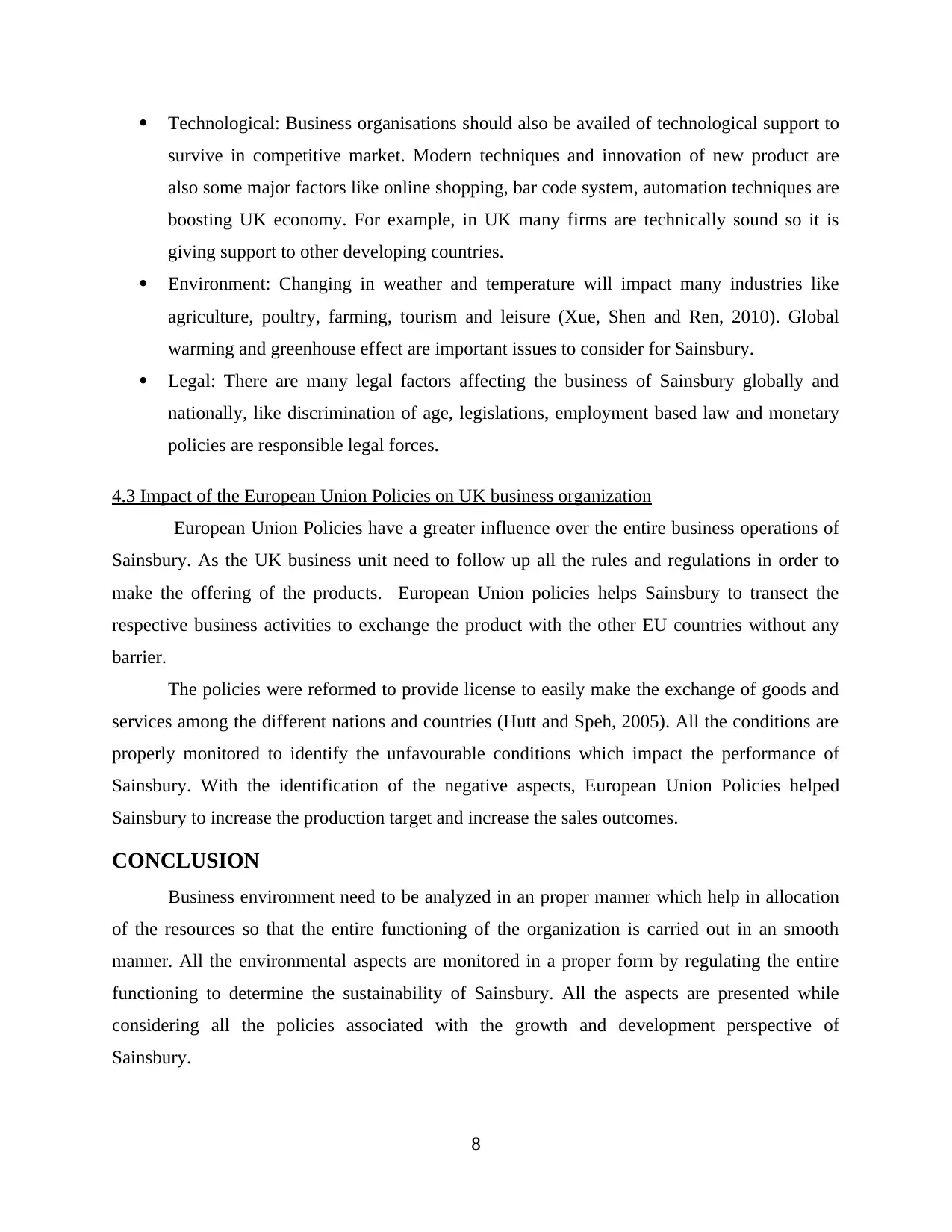
Technological: Business organisations should also be availed of technological support to
survive in competitive market. Modern techniques and innovation of new product are
also some major factors like online shopping, bar code system, automation techniques are
boosting UK economy. For example, in UK many firms are technically sound so it is
giving support to other developing countries.
Environment: Changing in weather and temperature will impact many industries like
agriculture, poultry, farming, tourism and leisure (Xue, Shen and Ren, 2010). Global
warming and greenhouse effect are important issues to consider for Sainsbury.
Legal: There are many legal factors affecting the business of Sainsbury globally and
nationally, like discrimination of age, legislations, employment based law and monetary
policies are responsible legal forces.
4.3 Impact of the European Union Policies on UK business organization
European Union Policies have a greater influence over the entire business operations of
Sainsbury. As the UK business unit need to follow up all the rules and regulations in order to
make the offering of the products. European Union policies helps Sainsbury to transect the
respective business activities to exchange the product with the other EU countries without any
barrier.
The policies were reformed to provide license to easily make the exchange of goods and
services among the different nations and countries (Hutt and Speh, 2005). All the conditions are
properly monitored to identify the unfavourable conditions which impact the performance of
Sainsbury. With the identification of the negative aspects, European Union Policies helped
Sainsbury to increase the production target and increase the sales outcomes.
CONCLUSION
Business environment need to be analyzed in an proper manner which help in allocation
of the resources so that the entire functioning of the organization is carried out in an smooth
manner. All the environmental aspects are monitored in a proper form by regulating the entire
functioning to determine the sustainability of Sainsbury. All the aspects are presented while
considering all the policies associated with the growth and development perspective of
Sainsbury.
8
survive in competitive market. Modern techniques and innovation of new product are
also some major factors like online shopping, bar code system, automation techniques are
boosting UK economy. For example, in UK many firms are technically sound so it is
giving support to other developing countries.
Environment: Changing in weather and temperature will impact many industries like
agriculture, poultry, farming, tourism and leisure (Xue, Shen and Ren, 2010). Global
warming and greenhouse effect are important issues to consider for Sainsbury.
Legal: There are many legal factors affecting the business of Sainsbury globally and
nationally, like discrimination of age, legislations, employment based law and monetary
policies are responsible legal forces.
4.3 Impact of the European Union Policies on UK business organization
European Union Policies have a greater influence over the entire business operations of
Sainsbury. As the UK business unit need to follow up all the rules and regulations in order to
make the offering of the products. European Union policies helps Sainsbury to transect the
respective business activities to exchange the product with the other EU countries without any
barrier.
The policies were reformed to provide license to easily make the exchange of goods and
services among the different nations and countries (Hutt and Speh, 2005). All the conditions are
properly monitored to identify the unfavourable conditions which impact the performance of
Sainsbury. With the identification of the negative aspects, European Union Policies helped
Sainsbury to increase the production target and increase the sales outcomes.
CONCLUSION
Business environment need to be analyzed in an proper manner which help in allocation
of the resources so that the entire functioning of the organization is carried out in an smooth
manner. All the environmental aspects are monitored in a proper form by regulating the entire
functioning to determine the sustainability of Sainsbury. All the aspects are presented while
considering all the policies associated with the growth and development perspective of
Sainsbury.
8
Paraphrase This Document
Need a fresh take? Get an instant paraphrase of this document with our AI Paraphraser
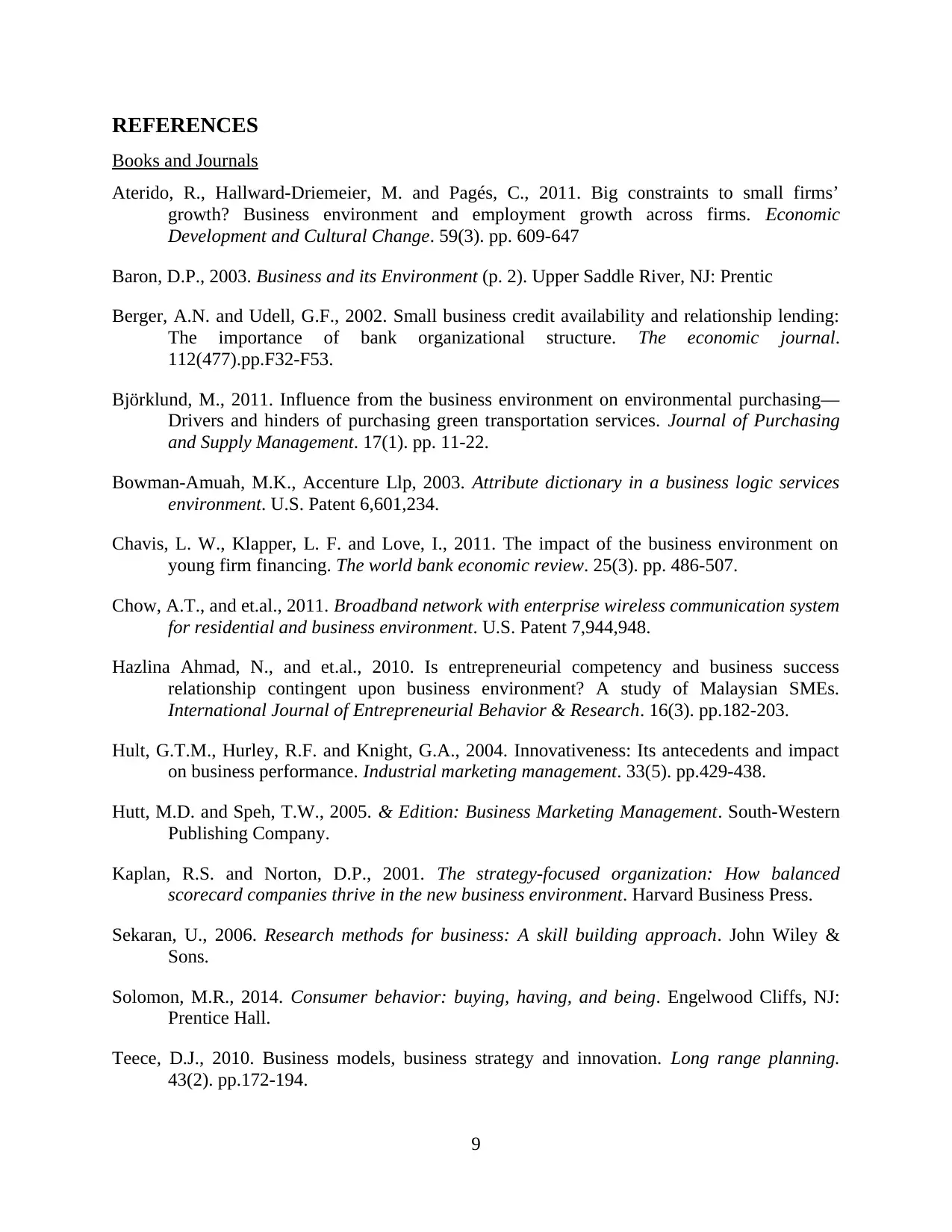
REFERENCES
Books and Journals
Aterido, R., Hallward-Driemeier, M. and Pagés, C., 2011. Big constraints to small firms’
growth? Business environment and employment growth across firms. Economic
Development and Cultural Change. 59(3). pp. 609-647
Baron, D.P., 2003. Business and its Environment (p. 2). Upper Saddle River, NJ: Prentic
Berger, A.N. and Udell, G.F., 2002. Small business credit availability and relationship lending:
The importance of bank organizational structure. The economic journal.
112(477).pp.F32-F53.
Björklund, M., 2011. Influence from the business environment on environmental purchasing—
Drivers and hinders of purchasing green transportation services. Journal of Purchasing
and Supply Management. 17(1). pp. 11-22.
Bowman-Amuah, M.K., Accenture Llp, 2003. Attribute dictionary in a business logic services
environment. U.S. Patent 6,601,234.
Chavis, L. W., Klapper, L. F. and Love, I., 2011. The impact of the business environment on
young firm financing. The world bank economic review. 25(3). pp. 486-507.
Chow, A.T., and et.al., 2011. Broadband network with enterprise wireless communication system
for residential and business environment. U.S. Patent 7,944,948.
Hazlina Ahmad, N., and et.al., 2010. Is entrepreneurial competency and business success
relationship contingent upon business environment? A study of Malaysian SMEs.
International Journal of Entrepreneurial Behavior & Research. 16(3). pp.182-203.
Hult, G.T.M., Hurley, R.F. and Knight, G.A., 2004. Innovativeness: Its antecedents and impact
on business performance. Industrial marketing management. 33(5). pp.429-438.
Hutt, M.D. and Speh, T.W., 2005. & Edition: Business Marketing Management. South-Western
Publishing Company.
Kaplan, R.S. and Norton, D.P., 2001. The strategy-focused organization: How balanced
scorecard companies thrive in the new business environment. Harvard Business Press.
Sekaran, U., 2006. Research methods for business: A skill building approach. John Wiley &
Sons.
Solomon, M.R., 2014. Consumer behavior: buying, having, and being. Engelwood Cliffs, NJ:
Prentice Hall.
Teece, D.J., 2010. Business models, business strategy and innovation. Long range planning.
43(2). pp.172-194.
9
Books and Journals
Aterido, R., Hallward-Driemeier, M. and Pagés, C., 2011. Big constraints to small firms’
growth? Business environment and employment growth across firms. Economic
Development and Cultural Change. 59(3). pp. 609-647
Baron, D.P., 2003. Business and its Environment (p. 2). Upper Saddle River, NJ: Prentic
Berger, A.N. and Udell, G.F., 2002. Small business credit availability and relationship lending:
The importance of bank organizational structure. The economic journal.
112(477).pp.F32-F53.
Björklund, M., 2011. Influence from the business environment on environmental purchasing—
Drivers and hinders of purchasing green transportation services. Journal of Purchasing
and Supply Management. 17(1). pp. 11-22.
Bowman-Amuah, M.K., Accenture Llp, 2003. Attribute dictionary in a business logic services
environment. U.S. Patent 6,601,234.
Chavis, L. W., Klapper, L. F. and Love, I., 2011. The impact of the business environment on
young firm financing. The world bank economic review. 25(3). pp. 486-507.
Chow, A.T., and et.al., 2011. Broadband network with enterprise wireless communication system
for residential and business environment. U.S. Patent 7,944,948.
Hazlina Ahmad, N., and et.al., 2010. Is entrepreneurial competency and business success
relationship contingent upon business environment? A study of Malaysian SMEs.
International Journal of Entrepreneurial Behavior & Research. 16(3). pp.182-203.
Hult, G.T.M., Hurley, R.F. and Knight, G.A., 2004. Innovativeness: Its antecedents and impact
on business performance. Industrial marketing management. 33(5). pp.429-438.
Hutt, M.D. and Speh, T.W., 2005. & Edition: Business Marketing Management. South-Western
Publishing Company.
Kaplan, R.S. and Norton, D.P., 2001. The strategy-focused organization: How balanced
scorecard companies thrive in the new business environment. Harvard Business Press.
Sekaran, U., 2006. Research methods for business: A skill building approach. John Wiley &
Sons.
Solomon, M.R., 2014. Consumer behavior: buying, having, and being. Engelwood Cliffs, NJ:
Prentice Hall.
Teece, D.J., 2010. Business models, business strategy and innovation. Long range planning.
43(2). pp.172-194.
9
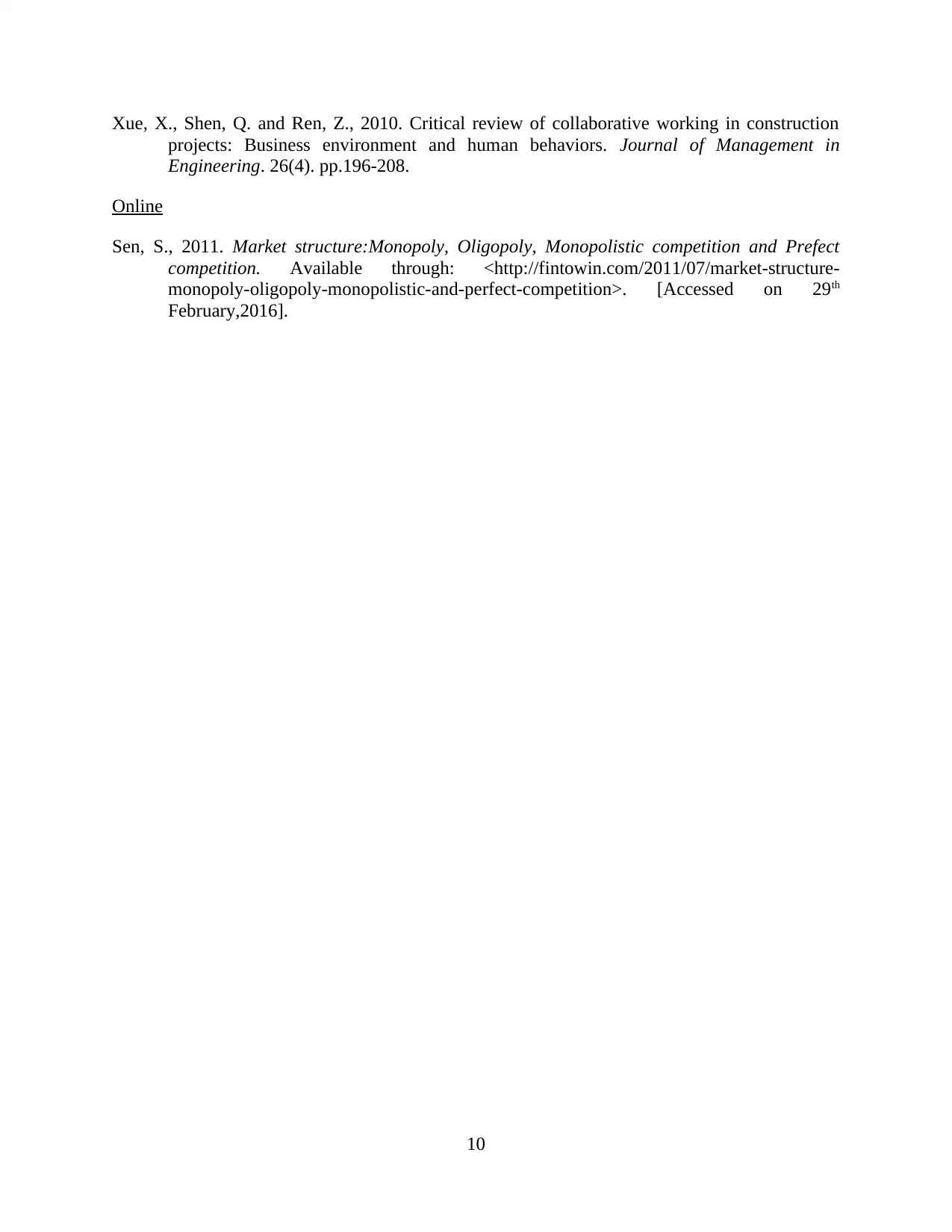
Xue, X., Shen, Q. and Ren, Z., 2010. Critical review of collaborative working in construction
projects: Business environment and human behaviors. Journal of Management in
Engineering. 26(4). pp.196-208.
Online
Sen, S., 2011. Market structure:Monopoly, Oligopoly, Monopolistic competition and Prefect
competition. Available through: <http://fintowin.com/2011/07/market-structure-
monopoly-oligopoly-monopolistic-and-perfect-competition>. [Accessed on 29th
February,2016].
10
projects: Business environment and human behaviors. Journal of Management in
Engineering. 26(4). pp.196-208.
Online
Sen, S., 2011. Market structure:Monopoly, Oligopoly, Monopolistic competition and Prefect
competition. Available through: <http://fintowin.com/2011/07/market-structure-
monopoly-oligopoly-monopolistic-and-perfect-competition>. [Accessed on 29th
February,2016].
10
⊘ This is a preview!⊘
Do you want full access?
Subscribe today to unlock all pages.

Trusted by 1+ million students worldwide
1 out of 12
Related Documents
Your All-in-One AI-Powered Toolkit for Academic Success.
+13062052269
info@desklib.com
Available 24*7 on WhatsApp / Email
![[object Object]](/_next/static/media/star-bottom.7253800d.svg)
Unlock your academic potential
Copyright © 2020–2025 A2Z Services. All Rights Reserved. Developed and managed by ZUCOL.





